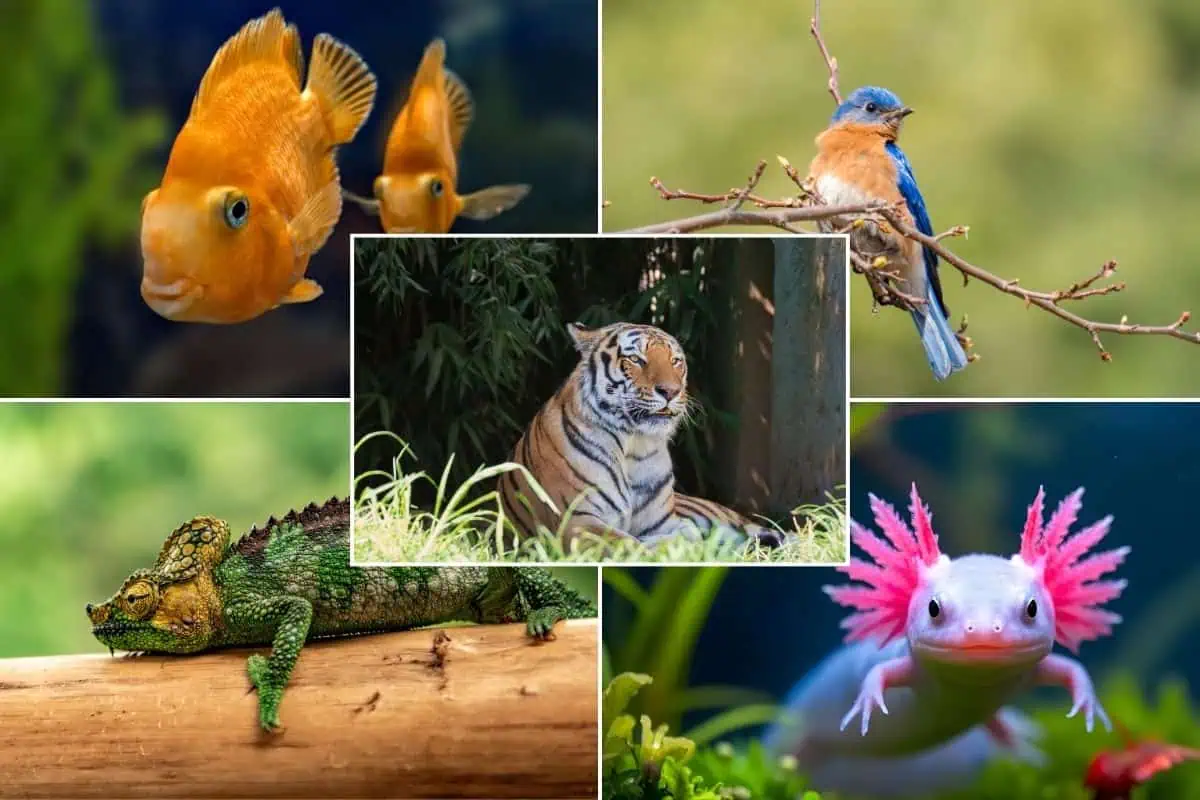Vertebrates probably make up most of the animals you see every day… unless you’re an entomologist. From goldfish to humans, they all share one key trait, a backbone. These animals can be found in nearly every environment on Earth. There are five main types of vertebrates, and in this article we’ll look at each one and the unique traits that help them thrive in their environments.
Article highlights
- Vertebrates are animals with backbones
- There are five main groups: fish, amphibians, reptiles, birds, and mammals
- Each group has unique traits that help them survive in different environments
What is a vertebrate?
First, let’s define what a vertebrate is. A vertebrate is an animal that has a backbone. More specifically, a flexible column made of small bones called vertebrae that protect the spinal cord and support the body.
This single feature separates vertebrates from animals without backbones, known as invertebrates. All vertebrates also have an internal skeleton, a skull to protect the brain, and a complex nervous system that helps them sense and respond to their surroundings.
The 5 main types of vertebrates
All vertebrates share the same basic structure, but each group has adapted to its environment in unique ways. These are the five main types of vertebrates and what makes each one special.
1 Fish

Fish are the first cold-blooded vertebrates on the list. They live in water and breathe using gills. Their bodies are covered in scales, and they have fins to help them swim and balance. Fish are the oldest vertebrates on Earth, with fossils dating back more than 500 million years.
There are thousands of species of fish, from tiny minnows to massive sharks. Some live in freshwater rivers and lakes, while others live in saltwater oceans. They lay eggs, and most species are ectothermic, meaning their body temperature changes with the water around them.
2 Amphibians

Amphibians are cold-blooded vertebrates that spend part of their lives in water and part on land. Frogs, toads, salamanders, and newts are all examples. They start life as larvae breathing through gills, then develop lungs as they grow into adults.
Their skin is thin and moist, allowing them to absorb oxygen directly from the environment. Because of this, amphibians are very sensitive to pollution and changes in their habitats. Most amphibians lay their eggs in water, and their life cycle shows how animals can adapt between land and water.
3 Reptiles

Reptiles are also cold-blooded vertebrates with dry, scaly skin that helps prevent water loss. They include snakes, lizards, turtles, and crocodiles. Unlike amphibians, reptiles lay eggs with protective shells on land, which keeps them from drying out.
Reptiles breathe air through lungs and rely on external heat sources to regulate their body temperature. Many are excellent hunters, using stealth, speed, or powerful jaws to capture prey. Reptiles were among the first vertebrates fully adapted to life on land, and their descendants include modern birds.
4 Birds

Birds are warm-blooded vertebrates with feathers, wings, and beaks. They lay hard-shelled eggs and have hollow bones that make them lightweight for flight. While most birds can fly, some like penguins and ostriches cannot, but they still share the same defining traits.
Feathers help birds stay warm and are key for flight and display. Birds have excellent vision, fast metabolisms, and strong hearts to power their movement. From tiny hummingbirds to massive eagles, birds live on every continent and are among the most diverse vertebrates on Earth.
5 Mammals

Mammals are warm-blooded vertebrates covered in hair or fur. They give live birth, with a few exceptions like the platypus, and feed their young with milk produced by mammary glands. Mammals include humans, whales, bats, elephants, and countless other species.
You can find mammals in nearly every environment, from ocean depths to polar regions. Their ability to regulate body temperature, care for their young, and adapt to complex environments makes them one of the most successful groups of vertebrates on the planet.
Comparison table of vertebrate types
| Group | Body covering | Body temperature | Reproduction | Examples |
|---|---|---|---|---|
| Fish | Scales | Cold-blooded | Lay eggs in water | Trout, shark, goldfish |
| Amphibians | Smooth, moist skin | Cold-blooded | Lay eggs in water | Frog, toad, salamander |
| Reptiles | Scales | Cold-blooded | Lay eggs on land | Snake, lizard, turtle |
| Birds | Feathers | Warm-blooded | Lay hard-shelled eggs | Robin, eagle, penguin |
| Mammals | Hair or fur | Warm-blooded | Give live birth, nurse young | Human, whale, lion |
Why vertebrates are important
Vertebrates play key roles in ecosystems everywhere. Fish keep waterways balanced, amphibians control insect populations, and reptiles maintain food chains as both predator and prey. Birds pollinate plants and spread seeds, while mammals shape forests and grasslands through their feeding and movement patterns.
People also rely on vertebrates for food, companionship, and research. By understanding them, you learn more about how life has evolved and how animals adapt to changing environments.
In the end
All vertebrates share one powerful connection, their backbone. That single feature supports everything from tiny fish to towering giraffes. While each group has evolved its own remarkable traits, they all show how creative life on Earth can be when it comes to surviving and thriving.
WildlifeInformer.com is your #1 source for free information about all types of wildlife and exotic pets. We also share helpful tips and guides on a variety of topics related to animals and nature. Subscribe on YouTube for videos.
